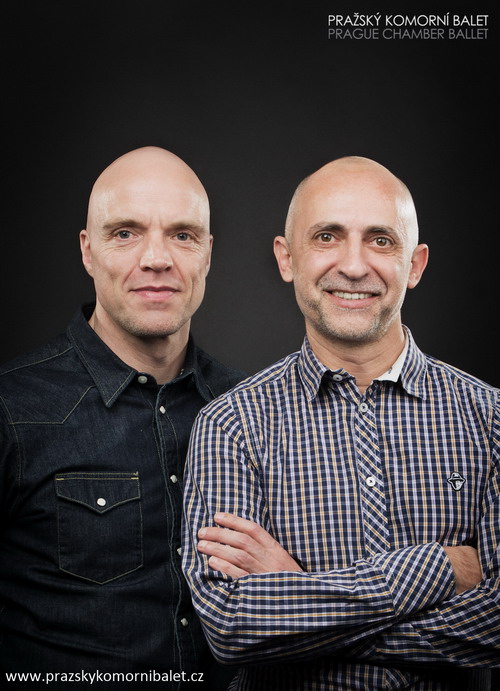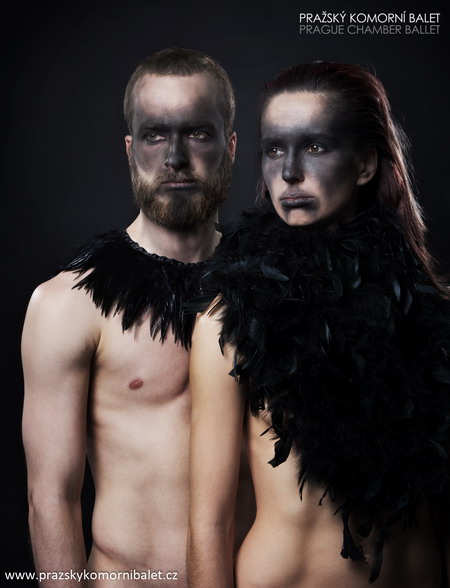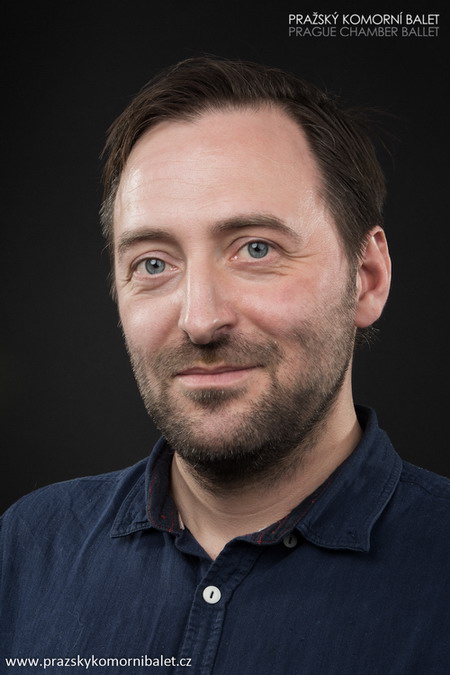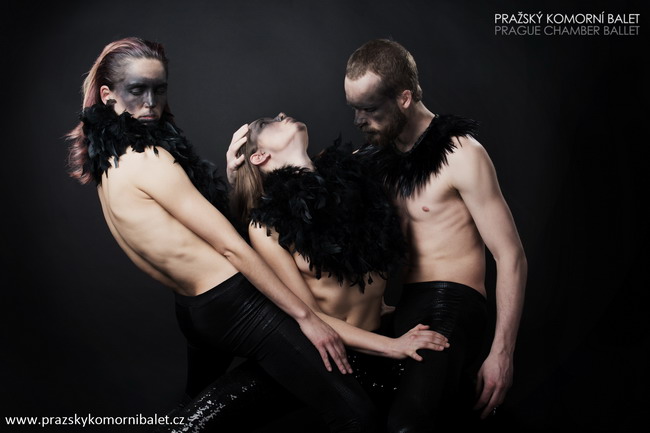 On April 16, 2014, Prague Chamber Ballet is to present this season’s second original project: BEAT created by the renowned choreographic tandem Ivgi & Greben. Uri Ivgi and Johan Greben are no strangers for the Prague audience – six years ago they collaborated with the National Theatre ballet company and now returned to compose a more chamber piece for this small progressive company. We met some time in the middle of the process. The two choreographers spent several weeks with the company and now they are prepared to finish the work. Another important co-creator, musician and composer, Mr. Tom Parkinson joined them a few days ago in Prague, so this was the opportunity to talk to them as an almost complete team.
On April 16, 2014, Prague Chamber Ballet is to present this season’s second original project: BEAT created by the renowned choreographic tandem Ivgi & Greben. Uri Ivgi and Johan Greben are no strangers for the Prague audience – six years ago they collaborated with the National Theatre ballet company and now returned to compose a more chamber piece for this small progressive company. We met some time in the middle of the process. The two choreographers spent several weeks with the company and now they are prepared to finish the work. Another important co-creator, musician and composer, Mr. Tom Parkinson joined them a few days ago in Prague, so this was the opportunity to talk to them as an almost complete team.First of all, could you tell us something more concrete about the topic and the sources of inspiration for BEAT?
U. I.: The basic inspiration is how people live today in this hectic world, how they seek their roots, how they miss the feeling of belonging to a certain group. The main subject is a phenomenon of the ritual – participating on a ritual is exactly the way we try to find our roots. We try to find a group of people that connect us to something we have in common, a group of people we can share things with and where we can experience a ritual that leads us to ecstasy. We live surrounded with technologies and we miss those basic things.
J. G.: This piece doesn’t tell story, but emotions and ideas. We’ve been playing with some ideas of ceremonies, group gathering, birth, growing, sharing energy, sharing things that relate us to each other. We think about the energy, how people can share it and celebrate it. It’s a bit contrasting to today’s world. People get connected very easily through new media, but they miss personal communication, human contact.
Do you have some particular inspiration in existing rituals?
U. I.: As you know, I come from Israel, very religious country where rituals are part of the life. But you can see some kinds of rituals all over the world, whether it is a religious thing or just something that you practice regularly. I think each one of us has something very spiritual in him and also a need of doing things regularly. Even taking everyday ballet class becomes a ritual, or doing yoga or meditation. And even the fact that you have a specific time to eat your dinner and have an afternoon cup of coffee, it also is ritual thing.
In the choreographic composition this aspect also lies in using particular movements and the quality of the movement: for example dancing in the circle is immediately associated with something that is ritual. And the dance is much “grounded”, connected to the floor; we really try to find the roots in the connection with the ground.
How do you deal with the space of the New Stage? Have you been there, have you had space rehearsals already?
J. G.: The theatre is usually bigger than the space where you rehearse. We already know the difference and think ahead. We went to see some performances at the New Stage, so we know the space, but we didn’t rehearse there yet. This weekend we were in Studio ALTA. We won’t have much time to rehearse in the theatre, but we have enough information to prepare. New Stage has a nice atmosphere; it is a wonderful space for contemporary dance. It is great to have such a huge space, but still the audience can stay in touch with the performers. But it depends on how you use the space.
U. I.: We have no sets, just light, that defines the space, where you can keep the energy of the dance.
Do you use dancers´ voices or sounds?
U. I.: We work with text and rhythm. It is not a song actually; we may describe it as a “group monologue”. Not a real text, it is more just single words, very simple words, sentences that relate to the topic, words that repeat. I think everybody will understand the meaning. We hope that the audience will build their own associations based on the words. We do not play with the meanings, but compose, rather use words as objects.
“We like to give the dancers freedom, we use their personalities.”
 Can you describe the process of creation on the example of this piece?
Can you describe the process of creation on the example of this piece?J. G.: We had concrete ideas of concepts like tribe, ceremony, birth, ritual. Then we went to the studio with a bunch of dancers, searched material, sometimes got incredibly lost, but suddenly it started to emerge. The piece turned into something we actually did not have in mind before. We took inspiration from all the ideas, impulses, the dancers, their improvisation, from the space of the dance studio… the piece grew up from the process.
And also Tom, our composer involves himself in the creation now. We normally are two creators but for example today we really were three for the whole day.
T. P.: We always talk a lot about the piece at the beginning and when discussing the ideas, it starts to make noises in my head so I go and work on it. I often come up with music they don’t like at the first time, but we slowly come to the direction of the piece and the music. We are trying to capture the piece together.
U. I.: During the process, we send Tom the material we do in the studio, so that he can see how the piece is developing. And the music also develops. Then he comes to the studio and we hear the music live and make lots of changes again. You know, watching a video and seeing dancers live is a very different feeling.
How about the dancers? Do you think they are creative; do they involve themselves in the process?
J. G.: Yes and it is very important for us. Our impression is that they are very involved, they can improvise with the existing material creating something new and we as choreographers work with their material again. We get inspired and talk with them about energy and certain qualities of the movements.
U. I.: Creating a piece is a process and it takes some time for the dancers to get to know us and vice versa. It doesn’t work in such way that we would just come, show them the choreography and tell them: “This is how it will be and end to it”. No, we have ideas and we use them but without the spirit of the dancers, it would not come into what we want.
Did you choose the cast for the show?
J. G.: Well, the company is not big and we held an audition and selected a few dancers for the project. Now we work with six dancers. There are two dancers, who we worked with in the National Theatre before, and two dancers, who took our workshop, so we know them and they know us. But for all of us it took some time to find the right way how to work on it.
Do you work more with small or big companies? What is the difference?
J. G.: In general, we work with smaller companies. We like to work with such amount of dancers that we are still able to stay in touch with them. Sometime we work with a bigger company but we still select dancers. I think that in our collaboration with National Theatre we had the biggest cast. It is important to work very intensively with people to have them create. I cannot for example imagine myself working intensively with 25 individuals in six weeks… But with six people it is much more direct; it is also much better for them when they don’t have twenty colleagues around them, they feel the space better. Even when they do not do individual work, they are still individuals.
U. I.: We like to give the dancers freedom, we use their personalities. This is something I think we also did in the NT when we worked with the sixteen dancers. You could really see the personality of each one of them and that is indispensable for us. It is part of our work, to show the personality of the dancers, not just the composition or lines of the movement.
 What do you think about using new technologies in contemporary dance?
What do you think about using new technologies in contemporary dance?J. G.: We don’t use technologies; we are not very interested in such things. Our work is very physical and we want to see what we can do with the living body.
U. I.: It relates to what we said about the personalities. I see choreographers using those technologies, video projection and that stuff, but sometimes you don’t see the dancers. It’s very hard to choose what you should focus on: whether on the movie or the dancer…
J. G.: You always need to have a very good reason for using it. You have to be sure, why you want to use it, what it can support in the piece. It can’t be just accessory.
You’ve been doing projects together for years. Do you also work separately?
J. G.: In the past each one of us worked alone but since we have work together, all our projects have been done together.
U. I.: Yes, but other people are also important: we work with Tom as a musician or with light designer; everyone in the team is involved in the creation somehow.
Which one of you is more like a choreographer and a director? Does it change?
J. G.: It’s always both.
T. P.: Basically they always work with one more person and the two take roles that change from minute to minute. I sometime even don’t understand how it works J. I mean that despite having different opinion they manage to find common ground always and this is amazing. I never experienced it. Anyway, it is quite unusual to work in a partnership, isn’t it?
J. G.: For us it is very usual J.
T. P.: Sure, I work collaboratively a lot but in a very different situations and very different role.
U. I.: We created alone before and it took us some time to find our own language, to find how to work together. It’s almost like a relationship, like when you try to find a way how to live next to your partner.
“The collaborative relationship is something that takes a lot of time to develop.”
What is so special on working in such tandem?
U. I.: We are so strong when we work together and we trust each other even when we don’t agree on something. We have somehow developed this trust that we have in each other. Every time you start a new piece, you are very vulnerable, you don’t know what is going to happen, even with the experience you already have. We usually go to the studio two three weeks before we start working with the dancers, just to find the ideas, to inspire each other, to find ourselves, to understand each other. And then the music comes.
T. P.: The way we were working these days was amazing. We have worked together on several projects in the past, but I know it wouldn’t work this great way before. It’s about getting to know each other better and better. Now we can very happily, comfortably work in the studio and say things to the dancers without thinking about what the other guys think about it, feeling free. The collaborative relationship is something that takes a lot of time to develop. Now I think that what we do is very special and it came out of that collaborative making of several pieces, of the time we spent together. I cannot imagine working with anybody else this way and I think it even would not be good to try it.
So in one word, what is the magic of the collaborative relationship?
U. I.: Time and trust. Trust is the right word I think.
J. G.: And understanding; the situations when you don’t have to explain every idea from A to Z because you know that we do understand each other.
U. I.: This time we are three and sometime there are four of us, as we also have a light designer that is very involved in the process. But he always comes a bit later. Sometime we have also costume designer involved in the process.
How long have you three worked together?
T. P.: It was in 2001 for the first time, I think. Then we had a break, when I was trying to break through in popular music. Then we started again in 2011. We did five pieces together, but it is them who are the main creators. They have the ideas, they are the authors of the concept. But we talk it over and have very different roles. This has been great three years.
J. G.: I know that if I worked with some other musician, I would need to work harder, to explain him everything from the beginning and it would take more time. And I know that now Tom sees and knows what to do and I don’t need to tell him. Or just to show him the bottom line but this trust we have in each other, the three of us, makes it very easy.
 So you two do not even think of starting some project just on your own, individually?
So you two do not even think of starting some project just on your own, individually?U. I.: No, not really. Even if sometime I do not agree with Johan’s corrections and reactions, I still feel that I wouldn’t like to do a piece without him. We are like poles on magnet, working together in a balance.
J. G.: We made a choice at some point of the time to work together and we invested a lot in the work. We complete each other. But of course there is also a place for individuality. We don’t create every movement together. There is place for individual urge, for my feelings, my ideas, but it all comes together in the end.
U. I.: And it is a privilege to create with more people, to share ideas. You don’t have all the responsibility on yourself and it is also very nice to share your ideas and to get more ideas back. Maybe that’s fundamental: we don’t work from the ego. The ego is not something that brings us to work, the work itself is more important.
Ivgi & Greben
The first collaboration of Ivgi & Greben took place in 2003 with a new version of Carmen by invitation of Szeged Contemporary Ballet from Hungary. Carmen was received with great success in several international festivals. Since 2003 they created for Ballet am Rhein, DE; Dansgroep Amsterdam, Introdans and Scapino Ballet, NL; It dansa, ES; Korea National Contemporary Dance Company, KR; Modern Dance Turkey; National Theatre Ballet, CZ; Provincial Dances Theatre, RU; Scottish Dance Theatre, UK; Skânes Dansteater and Norrdans, SE and Tanzkompanie Theater St. Gallen, CH.
Ivgi & Greben won The Golden Mask Award 2011 in Moscow in the category Best Choreographer-Ballet/Contemporary Dance. They received this most important Theatre Prize for This is not a love song, which they created for the Provincial Dances Theatre in Yekaterinburg in Russia.
In 2013 Ivgi & Greben will create new works for Phoenix Dance Theatre in the UK and Provincial Dances Theater in Yekaterinburg in Russia. Photo by: ART DOT Studio




Josef Bartos
Thank you for your thoughts. One got stuck in my mind – that passion makes us different from AI. Just yesterday I read…I am a dance critic. I am a member of an endangered species